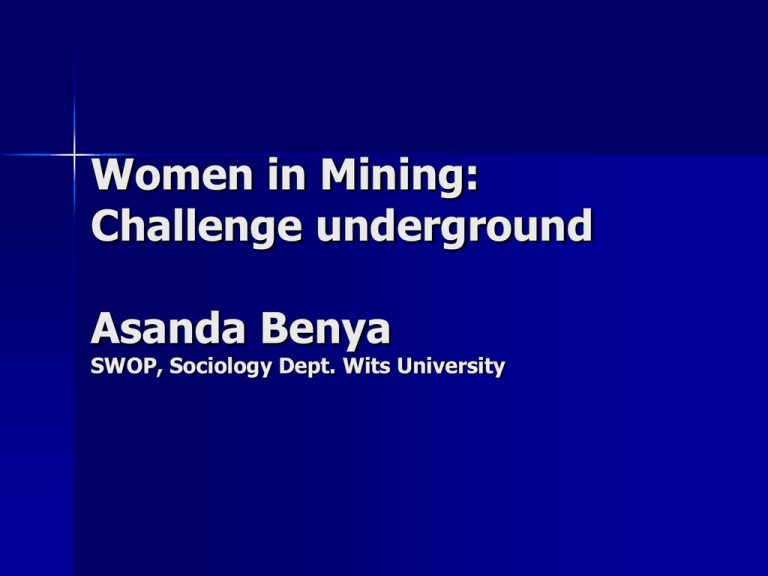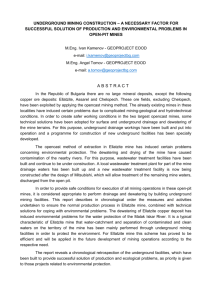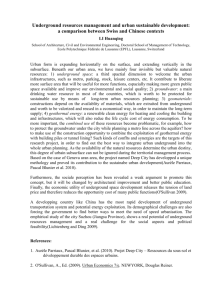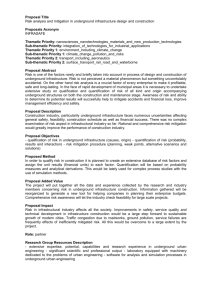
Women in Mining:
Challenge underground
Asanda Benya
SWOP, Sociology Dept. Wits University
Methodology
1.5 years inside the mines
Participant observation
- I trained and worked: labourer,
pikinini, winch
- lived with the workers
Challenges and coping mechanisms
Subjectivities
Women in Mining (WIM)
Background
WIM underground in SA is a new
phenomenon
Britain- Mines Act of 1842, ILO 1935
SA-Mineral Act of 1911 and 1991
New policies in SA that reverse these
prohibitions (1996:H & S, 2002:
MPRDA ,
2004: Mining Charter- 10% Women
New legislation targets taken seriously
Mines have drawn up strategies to help
integrate women
Pregnancy and sexual harassment
policies
Learnership and mentorship
programmes
Built separate change rooms on surface
Challenges remain
Who are these women
Women in mining VS Women at
mining and women for mining
Age 18-40 (reproductive years)
Single mothers
First full time job (contracts)
Unemployment and poverty
Financial security and benefits
What do they do
Attendants (belt, battery, cage)
Store issuers
Assistants (MO, SB)
Equipment helper
Winch operator and miners
No women RDOs
Formal and Informal job allocations
Heat Tolerance Screening
Mandatory for new recruits
Assess heat tolerance
Chamber kept at 28˚c wet bulb and 29.5˚c
dry bulb
Climb 24 times in a minute for 30 minutes
Stopping= heat intolerance and inability to
do manual work under hot and humid
conditions
People can be eliminated before they
undergo HTS
- weight, illnesses, emotional state
- initial body temperature (↓37˚c)
Women
- Pregnancy and breastfeeding,
- menstrual period
Completing does not mean pass
- 37.6˚c and below is a pass
- 37.7˚c and above is a fail
- 40˚c is indicative of heat stroke
Introduction
Working underground is a challenge
for women
Work is unpredictable underground
Culture of planisa
Women have also come up with their
own planisa methods
Challenges
Getting
to work
Inside the cage
One piece suits
Start at low ranks
Heat: men v.s women
Challenges
Physically challenging
Relations that exclude women
Removed spatially from stope
Training centre: masculinities
Tacit knowledge not filtering down
Fetch water, and help with easy tasks
challenges
Cultural beliefs and discourse of
protection (weak and lazy)
According to men their place is in the
kitchen not underground
Unions not taking gender seriously
Sexual harassment
Videos: conditions, H & S
Coping mechanisms
Informal job allocations underground
Carpet promotions: Sexual favours
Exaggerate & emphasize feminine traitstaking care of the family, menstruation,
period pains
They planisa- make a plan
– Fraudulent HTS stamps
– Mtshongolo pills
Use culture and traditions- sotho men and
their cultural obligation to assist women.
“If you call them Ntate, they’re more likely and willing to help
you… The more respect you give the older men, the more
they tend to side with you and help you accomplish tasks.
Ethnicity and kin ties- setswana and from
the same village
“men tend to accept you much quicker and are more willing to
assist you if you are of the same ethnic group as them”.
“She has her Tswana brothers here; she doesn’t need us to help
her”
Is Unionization the
solution?
Union rivalry (macro)
Gender bias: workplace issues &
alliance (national politics)
Wages
Gender solidarity- further victimization
Conspiracy of silence: don’t tell
(Rape)
Few women representatives
Unionization
Representation: Shopstewards,
- women structures (change house)
- organising desks
- complaints desk
- powerless
- legitimacy
- strategic silencing of women’s
voices
Unionization
Policies: exclusion of women
– Pregnancy: alternative employment,
financial vulnerabilities
– Housing: Obligated to families 1st
– Migration (60km radius)
– Sexual harassment
Conclusion
There are challenges that women face by
virtue of being women: sexual harassment
Unions not the answer for women within
Sexist ideology of domesticity
Collaborated with employers to further
exploit women (sexually and socially)
Incorporating women is not the solution
Women continue to be vulnerable and
exploited
Unions have failed, what are the
alternatives?












